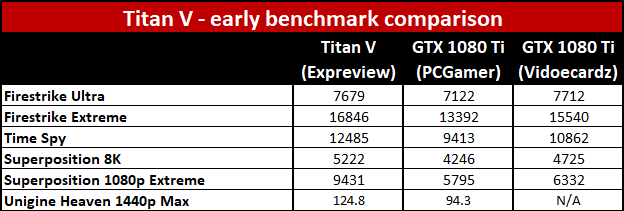Last week, Nvidia surprised everyone with the unveiling of its new Titan V graphics card. It’s important to note that the Titan V isn’t billed as a gaming card—Nvidia even told us directly that “Titan V is not for gaming” when I inquired about getting a review sample. Obviously, $2,999 for just a graphics card is an obscene amount of money, and I get that the most important feature for the target audience is the compute performance, specifically using algorithms that can leverage the Tensor cores, but we still want to know how it fares in other workloads. Thankfully, Videocardz and other places (including Reddit) have started to post some preliminary numbers.
As you might expect, the benefits of Nvidia’s new uber-GPU for gaming and graphics purposes aren’t all that large, especially considering the price. The GTX 1080 Ti has a nominal performance rating of 11.8 TFLOPS (boost), and the Titan V is rated at 14.9 TFLOPS (boost), both for single-precision FP32 workloads, but how that translates to actual games often depends on many other factors—CPU speed, RAM, resolution and quality settings, and the game/application being used. On paper, we would expect the Titan V to outpace the 1080 Ti by up to 25-30 percent. In practice, it’s sometimes a lot more than that… and sometimes a lot less. Here are the current results, using the posted Titan V numbers along with some of our own internal testing:

The difficulty in analyzing the current results is that we don’t have fully identical systems. The Titan V benchmarks were done with a Core i7-6700K, apparently running stock, and that immediately raises some concerns about CPU bottlenecks. Videocardz for its part used a Core i7-6800K, a different architecture running on a different platform, with different CPU clocks and core counts. Both the Titan V and Videocardz GPUs are also listed as overclocked, though specific details aren’t given. For my tests, I used an i7-8700K, running stock, with an MSI GTX 1080 Ti Gaming X (factory overclocked), giving a third data point.
The benchmarks we can easily compare include 3DMark and Unigine tests, aren’t always the best predictor of gaming performance. I tried running Rise of the Tomb Raider and Ashes of the Singularity benchmarks as well, but my results indicate either a significant difference in settings or some other factor, so I’ve omitted the game performance for now.
While Videocardz shows only modest improvements in performance, my GTX 1080 Ti numbers are quite a bit lower. Firestrike Ultra is only 8 percent faster, but Firestrike Extreme shows a 26 percent improvement, Time Spy a 33 percent increase, Heaven gives a 32 percent improvement, and Superposition gives 23 percent at 8K optimized and a whopping 63 percent increase at 1080p extreme.
Obviously there’s still the issue of real value, as even a 60 percent improvement is nothing compared with a price that’s four times as high. And while Nvidia says the Titan V isn’t for gaming, we’re still trying to get a card for testing, just to provide some concrete numbers. I also hope to run a few deep learning tests, to show what the Titan V can do with the right workload. But if you’re interested in playing games, I can only recommend holding off to see what the actual consumer models of Volta look like.
